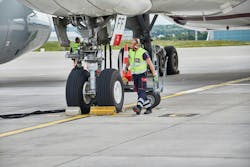How Ground Handlers Can Comply with Proposed EASA Regulations
Proposed European Union (EU) ground handling regulations are expected to be published in late 2024 or early 2025 and the European Union Aviation Safety Agency (EASA) has recommended a transition period of three years for implementation after the publication of the regulation.
Grace Period
As a rule, an EU regulation enters into force either the next day following its publication or 20 days after; this is specified in one of the articles of the regulation itself, explain EASA officials.
“However, the date of application can be set to be different from the date of entry into force, to provide the affected stakeholders with sufficient time to prepare for the implementation of the new ground handling regulation,” say officials at EASA.
According to Fabio Gamba, director general of the Airport Services Association (ASA), it is important to understand that what has been published earlier in 2024 is an opinion formulated by EASA as a specialized agency of the European Union.
“This is the termination of a process in which EASA has asked all the stakeholders to give their inputs. Before it becomes a regulation, there will have to be between 12 to 18 months for the European Commission to review and transform the opinion into a regulation,” he explains. “The work of the European Commission will be on the legal aspects to make sure that the new regulation does not impact on previous obligations of the European Commission or the member states.”
The regulation will be published in 2025, there will be a three-year grace period, and it will not be mandatory for implementation before 2028, explains Gamba.
“Therefore, there are altogether four years to prepare. This offers some flexibility in dealing with the issue and, above all, this allows time to establish contact with the competent authorities,” he says.
New Approach
In terms of the actual content of the rules, there needs to be a certain set of standards that ground handling companies largely already have in place, but there are new elements to prepare to establish compliance, Gamba points out.
“The regulations will not be telling us how to do our job, and that is not their intent, but they will simply make sure that there is a standard that is being applied consistently,” he says. “This is not coming with new obligations or new requirements. It is just taking what has already been done and making it applied in a slightly different way, in that for the first time the competent authorities are in charge of ensuring that a ground handling service provider (GHSP) is complying as declared. There are not really new obligations, but there will be a different way to look at how compliance is ensured.”
Until now, the ground handling industry operated under self-regulation, with operational arrangements, including safety considerations, primarily addressed in bilateral service agreements between ground handling service providers and the respective aircraft operators, point out representatives at dnata. “Concerning our operations, we anticipate a smooth transition, proactively aligning our practices with the forthcoming regulatory framework,” officials at dnata say.
According to Monika Mejstrikova, director of ground operations at the International Air Transport Association (IATA), there is a feeling of confidence with numerous GHSPs indicating their readiness for this regulation, which is reinforced by the IATA Safety Audit for Ground Operations (ISAGO) audit reports and results.
“This confidence stems from decades of collaborative industry efforts to establish global standards covering various aspects, such as GHSPs’ safety management systems (SMS), organization, management, training, operational procedures and ground support equipment (GSE) management,” she says. “Many GHSPs in the EU and beyond have already integrated these standards into their operations and management systems, positioning them well to comply with the regulation. GHSPs lagging in adoption will utilize the transition period to meet the requirements.”
Oversight
The new ground handling regulation will also embed requirements on information security management (Part-IS), for which a six-year transition period is proposed by EASA, to enable affected organizations to first prepare for the specific ground handling requirements and to benefit from the lessons learned in the other aviation domains that should implement the new requirements at an earlier date (2026), clarify representatives at EASA.
“At the same time, we are proposing a longer initial oversight period for the ground handling requirements (of five years, or 60 months), applicable only for the first oversight, not repetitive, with the purpose of enabling competent authorities to oversee all declared ground handling organizations in their member state at least once,” say EASA officials. “This exceptional, initial longer period for the oversight is considered a feasible solution to accommodate a comprehensive oversight for competent authorities having to audit a large number of ground handling organizations in their state.
“It is, however, not expected that all aerodromes where a ground handling organization provides services are overseen in this initial five-year nor within one oversight cycle.”
A smooth transition is proposed for organizations already providing ground handling services at the time when the ground handling regulations become applicable, highlights EASA representatives.
“They will have to agree with their competent authority on a period in which they may submit their declaration after the regulation enters into force; however, this should not be longer than 12 months starting from the date of application of the ground handling regulations,” officials at EASA say. “This interval will enable competent authorities to plan the oversight program more easily. Authorities should also consider, for oversight planning, the experience and performance of the ground handling organizations that have already been providing services prior to the date of application of the new ground handling regulations.”
Readiness Preparation
EASA is preparing the document (decision), including acceptable means of compliance (AMC) and guidance material (GM) associated with the ground handling regulations.
“The AMCs and GMs will provide support for the implementation of the regulations. The AMCs and GMs will be published soon after the commission publishes the ground handling regulations (within 1-2 months),” say EASA officials. “We will also prepare an implementation support campaign, in collaboration with the member states, to run during the transition period. This will consist in series of public events (workshops, webinars) and publication of frequently asked questions to further reach out to organizations affected by the regulations, to answer their questions, to clarify the intent of the regulations and the expectations, and to address the stakeholders’ concerns.”
Swissport was an active participant in the development of the EASA regulations and participates in the key IATA and industry groups that develop industry standards. Looking to transition to the new EASA regulations, Swissport already has an SMS in place and is operating in accordance with the IATA Ground Operations Manual (IGOM).
“As the world’s largest aviation ground services provider, we welcome EASA’s proposal for the implementation of ground handling regulations across Europe,” says Warwick Brady, president and chief executive officer (CEO) of Swissport International. “The regulations will ensure a better standard of operations and will help reinforce the critical role that ground handling plays in aviation safety.
“Together with EASA and ASA, we must make sure the regulations provide a level playing field for ground handlers to deliver safe and sustainable operations that support the wider environmental, social and corporate governance (ESG) agenda of the aviation industry,” he continues. “We now encourage other national authorities to implement the same requirements to deliver a truly global set of standards.”
More on EASA Ground Handling Regulations
EASA’s Proposal to Regulate Ground Handling
How EASA’s Proposed Ground Handling Regulations Complement Industry Standards
How Proposed EU Handling Regulations Will Impact Airports and Operators
You May Also Like
AviationPros Source eBook: Ramp Operations & Training
About the Author

Mario Pierobon
Dr. Mario Pierobon provides solutions in the areas of documentation, training and consulting to organizations operating in safety-sensitive industries. He has conducted a doctoral research project investigating aircraft ground handling safety. He may be reached at [email protected].
